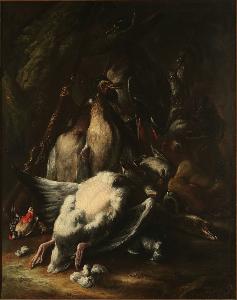Baldassarre De Caro
Baldassarre De Caro
Place: Naples
Born: 1689
Death: 1750
Biography:
Early Life and Training
De Caro's early life and training played a significant role in shaping his artistic style. As a pupil of Andrea Belvedere, he was exposed to various techniques and styles, which he later incorporated into his own work. De Caro's training alongside other notable artists, such as Tommaso Realfonso and Gaspare Lopez, also had a profound impact on his artistic development. Artistic Style and Influences
De Caro's artistic style was characterized by his use of vibrant colors and detailed compositions. He was particularly known for his still-life paintings, which often featured hunted game and flora. De Caro's work was influenced by Spanish Bodegones and Flemish painters, including Frans Snyders, David de Coninck, and Jan Fyt. His style was also shaped by the Neapolitan resident Abraham Brueghel. Notable Works and Legacy
De Caro's sons, Giuseppe and Lorenzo De Caro, were also still-life painters. Some of his notable works can be found in the Palumbo-Fossati Collection in Venice, Italy. The collection includes works by famous artists such as Thomas Moran, William James Glackens, and Gilbert Munger. De Caro's legacy can be seen in the many artists who have been inspired by his work, including those who have followed in his footsteps to create their own still-life masterpieces.
Conclusion
In conclusion, Baldassarre De Caro was a talented artist who left a lasting legacy in the world of still-life painting. His use of vibrant colors and detailed compositions has influenced generations of artists, and his work continues to be admired by art lovers around the world. As a master of still-life painting, De Caro's contributions to the art world are undeniable, and his legacy will continue to inspire artists for years to come. The Wikioo.org website provides more information about Baldassarre De Caro and his works, including a collection of his paintings and biographical details.

